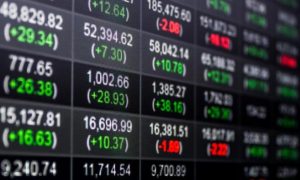U.S. stocks retreated in the final trading session of 2022, putting major indexes on track to close out a punishing year with further losses.
The S&P 500 fell 1.2% Friday, while the Dow Jones Industrial Average lost 1%. The Nasdaq Composite declined 1.3%.
Also Read – Why Tesla Stock Is Taking Off Today After 3-Session Slide
This year has proved to be one of the worst for markets in recent history, with stocks and bond prices both falling, and exceptional volatility roiling currencies and commodities. The S&P 500 has fallen 19% this year through Thursday, putting it on course for its worst year since the 2008 financial crisis. Bonds are on track for their worst year on record. And cryptocurrency prices have cratered, as a series of crises has gripped the emerging industry.
Money managers entered the year expecting that advances in the stock market would slow after three consecutive years of blockbuster gains. But few were prepared for how tough 2022 would be.
Inflation remained stickier than many on Wall Street expected, forcing the Federal Reserve to kick off its most aggressive interest-rate increases in decades. Russia’s war in Ukraine and the subsequent scrambling of energy markets caught traders off guard. And the specter of a global recession loomed.
With few places to hide, investors tossed out the strategies used since the financial crisis. Growth and momentum stocks—darlings of the Covid-19 pandemic—crumbled. Investors dashed for cash. The year’s selloff across asset classes was particularly bruising for so-called 60/40 investors, or those who put 60% of their money into stocks, and 40% into bonds.
“I’ve called it an anti-Goldilocks environment,” said Hani Redha, global multi-asset portfolio manager at PineBridge Investments. “I think [2022] was probably up there in terms of being one of the most difficult years to get right for market participants.”
Trading volumes this week have been light—a contrast to a hectic year in markets. Many traders had hoped the stock market would end the year on a high note, as part of what is colloquially known as the “Santa Claus rally.”
Also Read – 10 of the Most Common Amazon Shopping Mistakes People Make
U.S. stocks tend to rise during the Santa Claus rally period, averaging since 1950 a 1.3% gain during the last five trading sessions of the year and first two of the new year. So far, the benchmark index has risen about 0.7% through the first four days of the period.
Some growth stocks edged down Friday. Tesla fell 0.6%. The electric-vehicle maker is on pace to end 2022 as among the worst performers in the S&P 500 after enduring a rollercoaster month of trading.
Few investors expect market volatility to subside when the 2023 trading year kicks off next week. But some say they are hopeful the stock market could bottom sometime next year, kicking off a new rally.
“You still have high inflation which is moderating, you have a declining housing market, you have slowing growth—all that suggest a potential continued deterioration in the economy in the first part of 2023,” said Peter Essele, head of portfolio management for Commonwealth Financial Network. But, he added, that slowdown may eventually prompt the Fed to begin signaling next year the possibility of interest-rate cuts.
“That could set up a very nice picture for the latter half of 2023,” Mr. Essele said.
Fed Chairman Jerome Powell has said that the central bank isn’t likely to consider lowering interest rates until officials are certain that inflation is slowing toward the Fed’s goal of 2% sustained inflation.
In the government bond market, Treasury yields rose Friday. Yields and bond prices move in opposite directions. The yield on the benchmark 10-year U.S. Treasury note rose to 3.877%, from 3.833% Thursday.
The yield on the 10-year note is set to close out the year with its largest one-year yield gain on record, according to Dow Jones Market Data, based on data starting in 1977.
Elsewhere in markets, moves were muted Friday. Brent crude, the international benchmark for oil prices, fell 0.4% to $83.14 a barrel. Oil prices have been dragged lower this week by concerns about a surge in Covid-19 cases following China’s rapid reversal of pandemic restrictions.
Also Read– How Capricorn Season Affects Each Zodiac Sign’s Love Life Starting December 22, 2022
Overseas, the pan-continental Stoxx Europe 600 declined 0.9%, on pace to end the year with a roughly 12% loss, its largest since 2018.
In Asia, Hong Kong’s Hang Seng Index and mainland China’s Shanghai Composite both ended the year down 15%, despite small increases on Friday. Japan’s Nikkei 225 lost 9.4% for the year after finishing the day roughly flat.









































